Analysis of Young Adulthood: Psychology Essay on Theories
VerifiedAdded on 2023/01/16
|9
|2613
|53
Essay
AI Summary
This essay delves into the psychological aspects of young adulthood, examining it as a transitional phase between emerging and middle adulthood. It explores key theories including Piaget's cognitive developmental theory, Levinson's theory of seasons in adulthood, and Erikson's psychosocial theory, analyzing their relevance to the developmental period. The essay also considers the potential challenges and benefits of working with young adults, drawing on observations from the '7 Up' documentary series to illustrate real-world applications. It discusses the influence of factors like career, relationships, and social dynamics on young adults' lives, as well as the implications for social work practice, emphasizing the importance of addressing issues such as mental health, social integration, and the development of healthy relationships. The essay highlights limitations of these theories and suggests the need for comprehensive support for young adults, including the role of social workers in providing effective counseling and guidance to navigate the complexities of this life stage.

Running head: PARAPHRASE
PARAPHRASE
Name of the student
Name of the university
Author Note
PARAPHRASE
Name of the student
Name of the university
Author Note
Paraphrase This Document
Need a fresh take? Get an instant paraphrase of this document with our AI Paraphraser
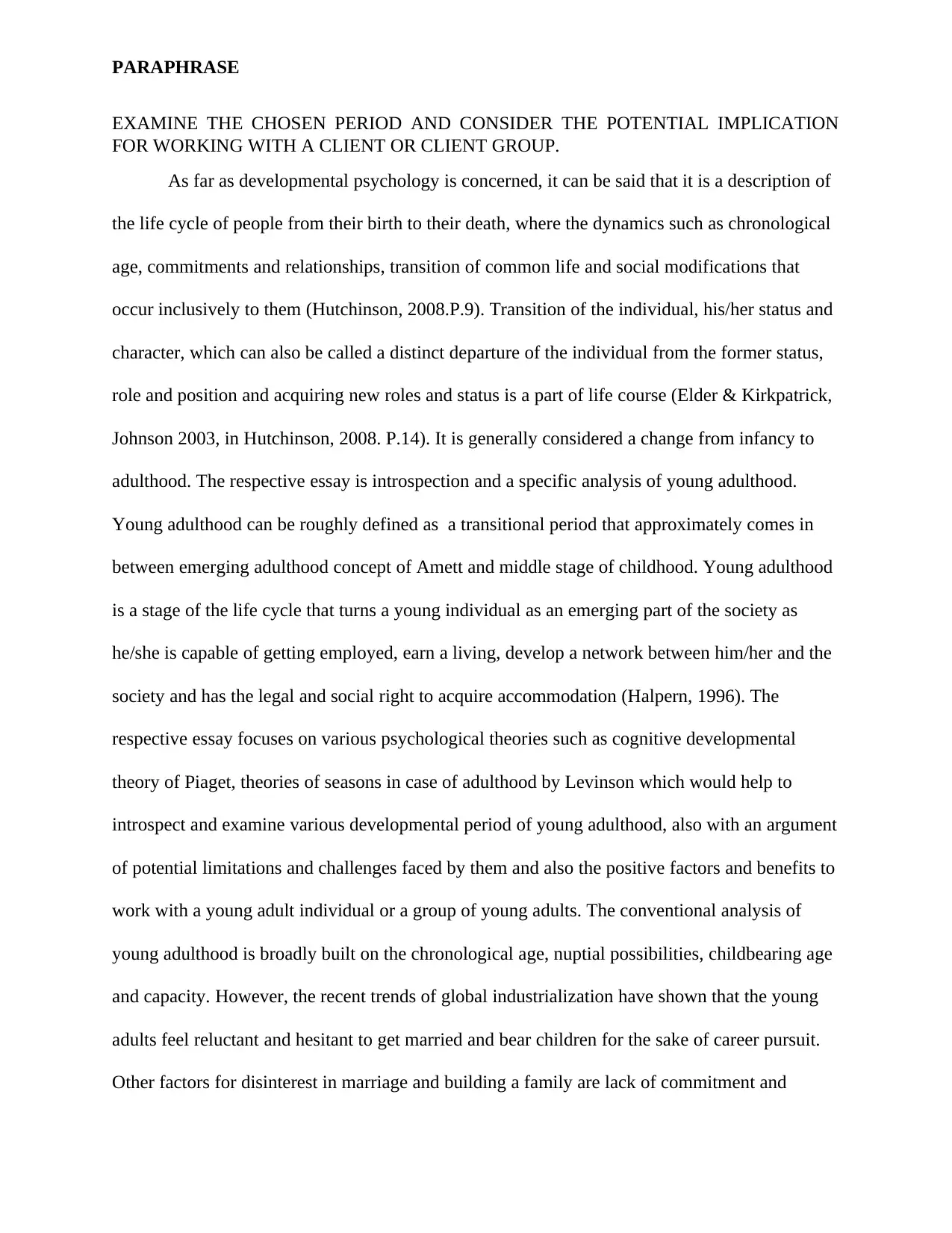
PARAPHRASE
EXAMINE THE CHOSEN PERIOD AND CONSIDER THE POTENTIAL IMPLICATION
FOR WORKING WITH A CLIENT OR CLIENT GROUP.
As far as developmental psychology is concerned, it can be said that it is a description of
the life cycle of people from their birth to their death, where the dynamics such as chronological
age, commitments and relationships, transition of common life and social modifications that
occur inclusively to them (Hutchinson, 2008.P.9). Transition of the individual, his/her status and
character, which can also be called a distinct departure of the individual from the former status,
role and position and acquiring new roles and status is a part of life course (Elder & Kirkpatrick,
Johnson 2003, in Hutchinson, 2008. P.14). It is generally considered a change from infancy to
adulthood. The respective essay is introspection and a specific analysis of young adulthood.
Young adulthood can be roughly defined as a transitional period that approximately comes in
between emerging adulthood concept of Amett and middle stage of childhood. Young adulthood
is a stage of the life cycle that turns a young individual as an emerging part of the society as
he/she is capable of getting employed, earn a living, develop a network between him/her and the
society and has the legal and social right to acquire accommodation (Halpern, 1996). The
respective essay focuses on various psychological theories such as cognitive developmental
theory of Piaget, theories of seasons in case of adulthood by Levinson which would help to
introspect and examine various developmental period of young adulthood, also with an argument
of potential limitations and challenges faced by them and also the positive factors and benefits to
work with a young adult individual or a group of young adults. The conventional analysis of
young adulthood is broadly built on the chronological age, nuptial possibilities, childbearing age
and capacity. However, the recent trends of global industrialization have shown that the young
adults feel reluctant and hesitant to get married and bear children for the sake of career pursuit.
Other factors for disinterest in marriage and building a family are lack of commitment and
EXAMINE THE CHOSEN PERIOD AND CONSIDER THE POTENTIAL IMPLICATION
FOR WORKING WITH A CLIENT OR CLIENT GROUP.
As far as developmental psychology is concerned, it can be said that it is a description of
the life cycle of people from their birth to their death, where the dynamics such as chronological
age, commitments and relationships, transition of common life and social modifications that
occur inclusively to them (Hutchinson, 2008.P.9). Transition of the individual, his/her status and
character, which can also be called a distinct departure of the individual from the former status,
role and position and acquiring new roles and status is a part of life course (Elder & Kirkpatrick,
Johnson 2003, in Hutchinson, 2008. P.14). It is generally considered a change from infancy to
adulthood. The respective essay is introspection and a specific analysis of young adulthood.
Young adulthood can be roughly defined as a transitional period that approximately comes in
between emerging adulthood concept of Amett and middle stage of childhood. Young adulthood
is a stage of the life cycle that turns a young individual as an emerging part of the society as
he/she is capable of getting employed, earn a living, develop a network between him/her and the
society and has the legal and social right to acquire accommodation (Halpern, 1996). The
respective essay focuses on various psychological theories such as cognitive developmental
theory of Piaget, theories of seasons in case of adulthood by Levinson which would help to
introspect and examine various developmental period of young adulthood, also with an argument
of potential limitations and challenges faced by them and also the positive factors and benefits to
work with a young adult individual or a group of young adults. The conventional analysis of
young adulthood is broadly built on the chronological age, nuptial possibilities, childbearing age
and capacity. However, the recent trends of global industrialization have shown that the young
adults feel reluctant and hesitant to get married and bear children for the sake of career pursuit.
Other factors for disinterest in marriage and building a family are lack of commitment and
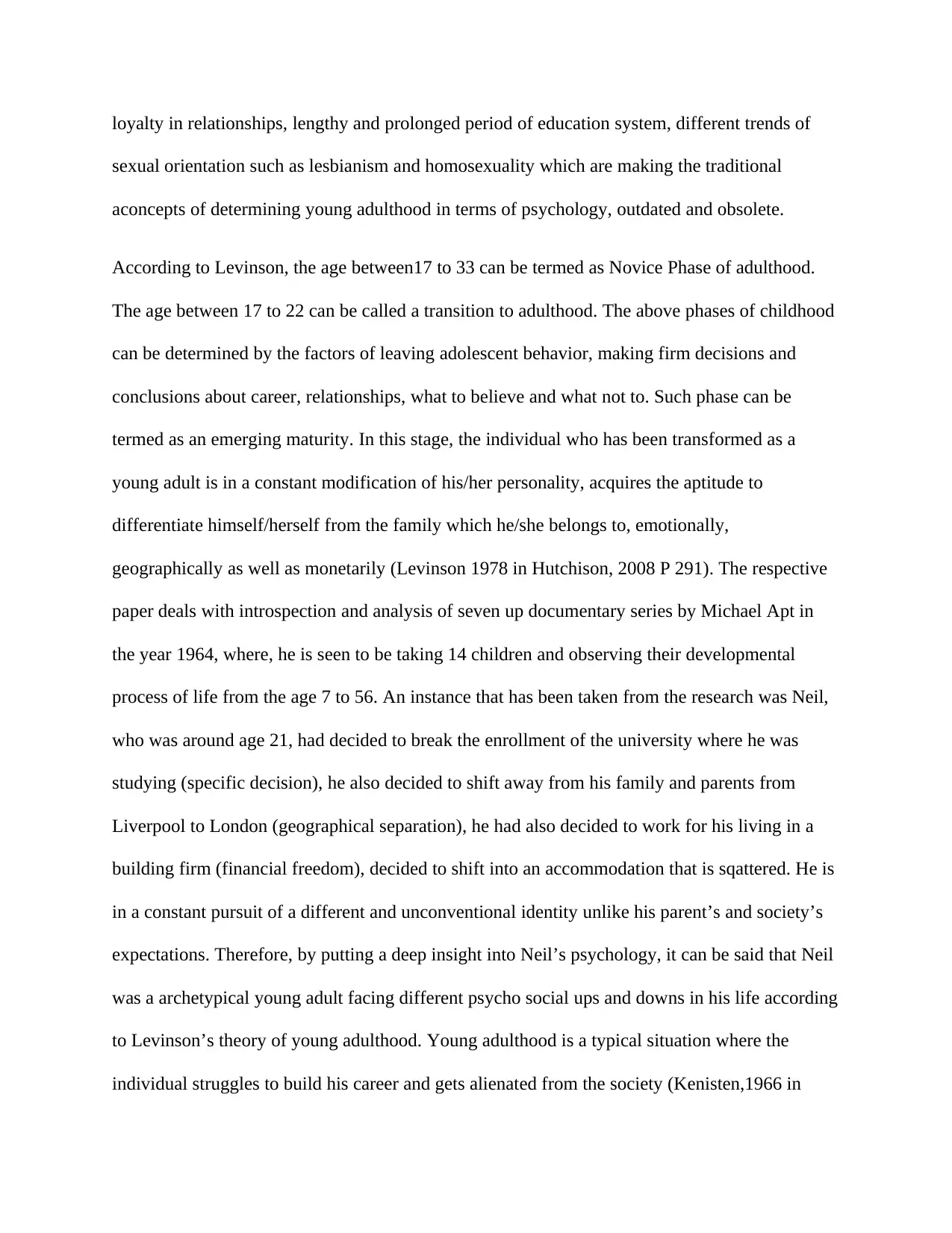
loyalty in relationships, lengthy and prolonged period of education system, different trends of
sexual orientation such as lesbianism and homosexuality which are making the traditional
aconcepts of determining young adulthood in terms of psychology, outdated and obsolete.
According to Levinson, the age between17 to 33 can be termed as Novice Phase of adulthood.
The age between 17 to 22 can be called a transition to adulthood. The above phases of childhood
can be determined by the factors of leaving adolescent behavior, making firm decisions and
conclusions about career, relationships, what to believe and what not to. Such phase can be
termed as an emerging maturity. In this stage, the individual who has been transformed as a
young adult is in a constant modification of his/her personality, acquires the aptitude to
differentiate himself/herself from the family which he/she belongs to, emotionally,
geographically as well as monetarily (Levinson 1978 in Hutchison, 2008 P 291). The respective
paper deals with introspection and analysis of seven up documentary series by Michael Apt in
the year 1964, where, he is seen to be taking 14 children and observing their developmental
process of life from the age 7 to 56. An instance that has been taken from the research was Neil,
who was around age 21, had decided to break the enrollment of the university where he was
studying (specific decision), he also decided to shift away from his family and parents from
Liverpool to London (geographical separation), he had also decided to work for his living in a
building firm (financial freedom), decided to shift into an accommodation that is sqattered. He is
in a constant pursuit of a different and unconventional identity unlike his parent’s and society’s
expectations. Therefore, by putting a deep insight into Neil’s psychology, it can be said that Neil
was a archetypical young adult facing different psycho social ups and downs in his life according
to Levinson’s theory of young adulthood. Young adulthood is a typical situation where the
individual struggles to build his career and gets alienated from the society (Kenisten,1966 in
sexual orientation such as lesbianism and homosexuality which are making the traditional
aconcepts of determining young adulthood in terms of psychology, outdated and obsolete.
According to Levinson, the age between17 to 33 can be termed as Novice Phase of adulthood.
The age between 17 to 22 can be called a transition to adulthood. The above phases of childhood
can be determined by the factors of leaving adolescent behavior, making firm decisions and
conclusions about career, relationships, what to believe and what not to. Such phase can be
termed as an emerging maturity. In this stage, the individual who has been transformed as a
young adult is in a constant modification of his/her personality, acquires the aptitude to
differentiate himself/herself from the family which he/she belongs to, emotionally,
geographically as well as monetarily (Levinson 1978 in Hutchison, 2008 P 291). The respective
paper deals with introspection and analysis of seven up documentary series by Michael Apt in
the year 1964, where, he is seen to be taking 14 children and observing their developmental
process of life from the age 7 to 56. An instance that has been taken from the research was Neil,
who was around age 21, had decided to break the enrollment of the university where he was
studying (specific decision), he also decided to shift away from his family and parents from
Liverpool to London (geographical separation), he had also decided to work for his living in a
building firm (financial freedom), decided to shift into an accommodation that is sqattered. He is
in a constant pursuit of a different and unconventional identity unlike his parent’s and society’s
expectations. Therefore, by putting a deep insight into Neil’s psychology, it can be said that Neil
was a archetypical young adult facing different psycho social ups and downs in his life according
to Levinson’s theory of young adulthood. Young adulthood is a typical situation where the
individual struggles to build his career and gets alienated from the society (Kenisten,1966 in
⊘ This is a preview!⊘
Do you want full access?
Subscribe today to unlock all pages.

Trusted by 1+ million students worldwide

PARAPHRASE
Hutchinson 2008 P290). Over here, Neil is observed to be struggling to build his career and
identity in the pursuit of financial and social independence, he is also eager to build his own
identity, ideology, belief system and tries to differentiate himself from the conventional societal
norms and constraints. However, Levinson’s theory was limited only to men and he did not
introspect the life of young adult women, therefore, his theories cannot be termed universal for a
community.
The cognitive 4 stage developmental theory by Piaget which is also called formal
operation stage, is a stage or a position in the life of a prospective young adult from the age of 11
when the individual starts developing cognition and cognitive abilities to utilize abstract ideas
and concepts for solving problems and in the reflection of his/her thought process (Matto, 2008
in Hutchinson, P.298). The sensorimotor at this stage that focuses on one framework at a time
which happens in stage one, the preoperational stage which is also called stage two where
symbolic functioning happens, the next stage of forming meanings, which is also stage three,
paves the way for logic in the operation mode to determine psychological development of a
prospective young adult. The unique subjective feeling of every individual young adult and his
abstract reasoning capabilities has always helped the young adults to take decisions ad opinions
in the matter of life objectives, roles, limitations and challenges (Labouvie-Vief, 1986,
Schaie,1982 in Hutchison, 2008, P 298). When the 7 year old Paul said that he did not want to
get married because he feared that his wife would compel him to eat vegetables and the 21 year
old Paul declared that he wanted to get married soon and be happy in his marriage, the theory
gives a clear comprehension about the changes and development of the mind of an individual
according to age.
Hutchinson 2008 P290). Over here, Neil is observed to be struggling to build his career and
identity in the pursuit of financial and social independence, he is also eager to build his own
identity, ideology, belief system and tries to differentiate himself from the conventional societal
norms and constraints. However, Levinson’s theory was limited only to men and he did not
introspect the life of young adult women, therefore, his theories cannot be termed universal for a
community.
The cognitive 4 stage developmental theory by Piaget which is also called formal
operation stage, is a stage or a position in the life of a prospective young adult from the age of 11
when the individual starts developing cognition and cognitive abilities to utilize abstract ideas
and concepts for solving problems and in the reflection of his/her thought process (Matto, 2008
in Hutchinson, P.298). The sensorimotor at this stage that focuses on one framework at a time
which happens in stage one, the preoperational stage which is also called stage two where
symbolic functioning happens, the next stage of forming meanings, which is also stage three,
paves the way for logic in the operation mode to determine psychological development of a
prospective young adult. The unique subjective feeling of every individual young adult and his
abstract reasoning capabilities has always helped the young adults to take decisions ad opinions
in the matter of life objectives, roles, limitations and challenges (Labouvie-Vief, 1986,
Schaie,1982 in Hutchison, 2008, P 298). When the 7 year old Paul said that he did not want to
get married because he feared that his wife would compel him to eat vegetables and the 21 year
old Paul declared that he wanted to get married soon and be happy in his marriage, the theory
gives a clear comprehension about the changes and development of the mind of an individual
according to age.
Paraphrase This Document
Need a fresh take? Get an instant paraphrase of this document with our AI Paraphraser
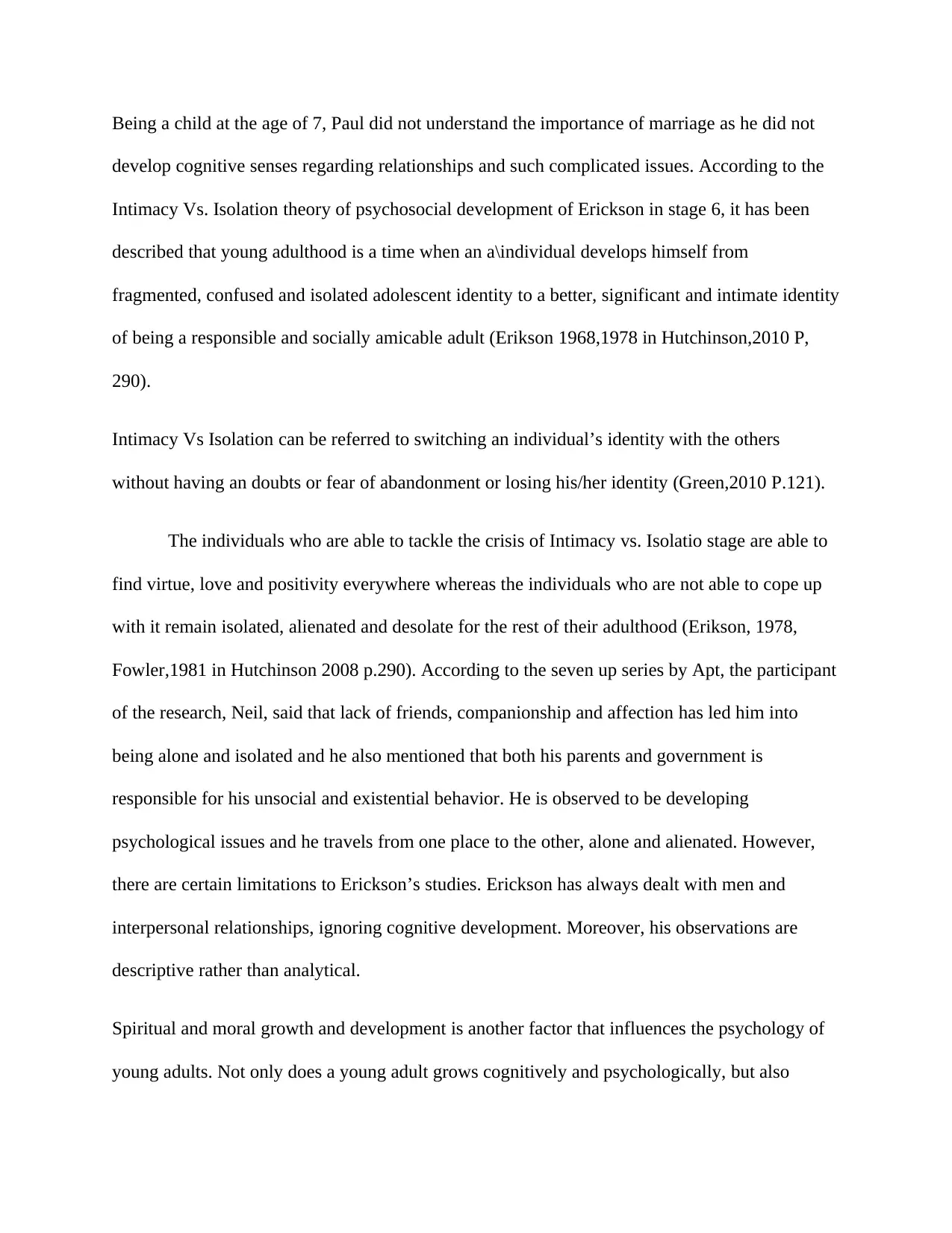
Being a child at the age of 7, Paul did not understand the importance of marriage as he did not
develop cognitive senses regarding relationships and such complicated issues. According to the
Intimacy Vs. Isolation theory of psychosocial development of Erickson in stage 6, it has been
described that young adulthood is a time when an a\individual develops himself from
fragmented, confused and isolated adolescent identity to a better, significant and intimate identity
of being a responsible and socially amicable adult (Erikson 1968,1978 in Hutchinson,2010 P,
290).
Intimacy Vs Isolation can be referred to switching an individual’s identity with the others
without having an doubts or fear of abandonment or losing his/her identity (Green,2010 P.121).
The individuals who are able to tackle the crisis of Intimacy vs. Isolatio stage are able to
find virtue, love and positivity everywhere whereas the individuals who are not able to cope up
with it remain isolated, alienated and desolate for the rest of their adulthood (Erikson, 1978,
Fowler,1981 in Hutchinson 2008 p.290). According to the seven up series by Apt, the participant
of the research, Neil, said that lack of friends, companionship and affection has led him into
being alone and isolated and he also mentioned that both his parents and government is
responsible for his unsocial and existential behavior. He is observed to be developing
psychological issues and he travels from one place to the other, alone and alienated. However,
there are certain limitations to Erickson’s studies. Erickson has always dealt with men and
interpersonal relationships, ignoring cognitive development. Moreover, his observations are
descriptive rather than analytical.
Spiritual and moral growth and development is another factor that influences the psychology of
young adults. Not only does a young adult grows cognitively and psychologically, but also
develop cognitive senses regarding relationships and such complicated issues. According to the
Intimacy Vs. Isolation theory of psychosocial development of Erickson in stage 6, it has been
described that young adulthood is a time when an a\individual develops himself from
fragmented, confused and isolated adolescent identity to a better, significant and intimate identity
of being a responsible and socially amicable adult (Erikson 1968,1978 in Hutchinson,2010 P,
290).
Intimacy Vs Isolation can be referred to switching an individual’s identity with the others
without having an doubts or fear of abandonment or losing his/her identity (Green,2010 P.121).
The individuals who are able to tackle the crisis of Intimacy vs. Isolatio stage are able to
find virtue, love and positivity everywhere whereas the individuals who are not able to cope up
with it remain isolated, alienated and desolate for the rest of their adulthood (Erikson, 1978,
Fowler,1981 in Hutchinson 2008 p.290). According to the seven up series by Apt, the participant
of the research, Neil, said that lack of friends, companionship and affection has led him into
being alone and isolated and he also mentioned that both his parents and government is
responsible for his unsocial and existential behavior. He is observed to be developing
psychological issues and he travels from one place to the other, alone and alienated. However,
there are certain limitations to Erickson’s studies. Erickson has always dealt with men and
interpersonal relationships, ignoring cognitive development. Moreover, his observations are
descriptive rather than analytical.
Spiritual and moral growth and development is another factor that influences the psychology of
young adults. Not only does a young adult grows cognitively and psychologically, but also
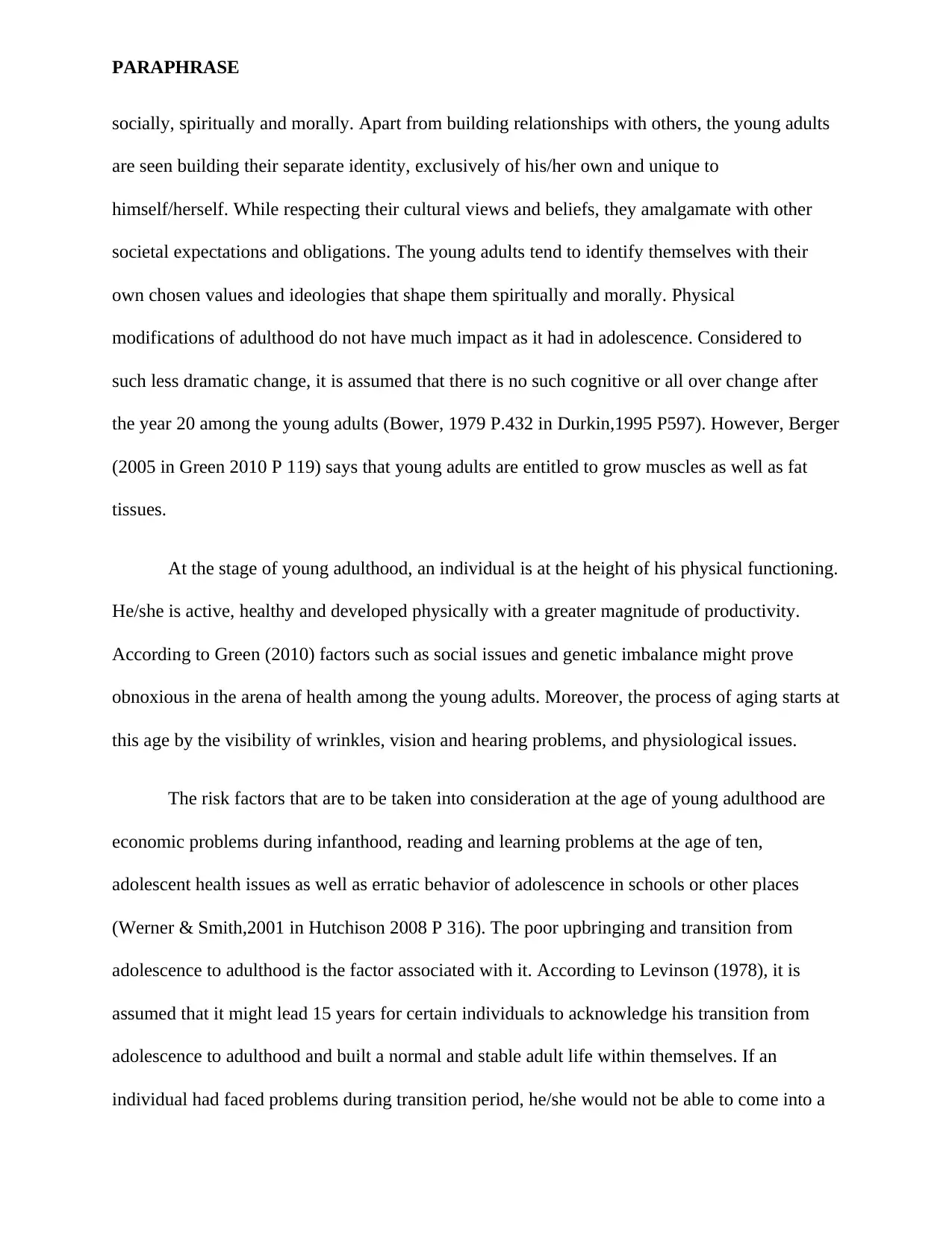
PARAPHRASE
socially, spiritually and morally. Apart from building relationships with others, the young adults
are seen building their separate identity, exclusively of his/her own and unique to
himself/herself. While respecting their cultural views and beliefs, they amalgamate with other
societal expectations and obligations. The young adults tend to identify themselves with their
own chosen values and ideologies that shape them spiritually and morally. Physical
modifications of adulthood do not have much impact as it had in adolescence. Considered to
such less dramatic change, it is assumed that there is no such cognitive or all over change after
the year 20 among the young adults (Bower, 1979 P.432 in Durkin,1995 P597). However, Berger
(2005 in Green 2010 P 119) says that young adults are entitled to grow muscles as well as fat
tissues.
At the stage of young adulthood, an individual is at the height of his physical functioning.
He/she is active, healthy and developed physically with a greater magnitude of productivity.
According to Green (2010) factors such as social issues and genetic imbalance might prove
obnoxious in the arena of health among the young adults. Moreover, the process of aging starts at
this age by the visibility of wrinkles, vision and hearing problems, and physiological issues.
The risk factors that are to be taken into consideration at the age of young adulthood are
economic problems during infanthood, reading and learning problems at the age of ten,
adolescent health issues as well as erratic behavior of adolescence in schools or other places
(Werner & Smith,2001 in Hutchison 2008 P 316). The poor upbringing and transition from
adolescence to adulthood is the factor associated with it. According to Levinson (1978), it is
assumed that it might lead 15 years for certain individuals to acknowledge his transition from
adolescence to adulthood and built a normal and stable adult life within themselves. If an
individual had faced problems during transition period, he/she would not be able to come into a
socially, spiritually and morally. Apart from building relationships with others, the young adults
are seen building their separate identity, exclusively of his/her own and unique to
himself/herself. While respecting their cultural views and beliefs, they amalgamate with other
societal expectations and obligations. The young adults tend to identify themselves with their
own chosen values and ideologies that shape them spiritually and morally. Physical
modifications of adulthood do not have much impact as it had in adolescence. Considered to
such less dramatic change, it is assumed that there is no such cognitive or all over change after
the year 20 among the young adults (Bower, 1979 P.432 in Durkin,1995 P597). However, Berger
(2005 in Green 2010 P 119) says that young adults are entitled to grow muscles as well as fat
tissues.
At the stage of young adulthood, an individual is at the height of his physical functioning.
He/she is active, healthy and developed physically with a greater magnitude of productivity.
According to Green (2010) factors such as social issues and genetic imbalance might prove
obnoxious in the arena of health among the young adults. Moreover, the process of aging starts at
this age by the visibility of wrinkles, vision and hearing problems, and physiological issues.
The risk factors that are to be taken into consideration at the age of young adulthood are
economic problems during infanthood, reading and learning problems at the age of ten,
adolescent health issues as well as erratic behavior of adolescence in schools or other places
(Werner & Smith,2001 in Hutchison 2008 P 316). The poor upbringing and transition from
adolescence to adulthood is the factor associated with it. According to Levinson (1978), it is
assumed that it might lead 15 years for certain individuals to acknowledge his transition from
adolescence to adulthood and built a normal and stable adult life within themselves. If an
individual had faced problems during transition period, he/she would not be able to come into a
⊘ This is a preview!⊘
Do you want full access?
Subscribe today to unlock all pages.

Trusted by 1+ million students worldwide

committed relationship or stick to a gainful employment. It is the responsibility of the social
workers to bring out the clients from such transitional victimization.
For a smooth and successful transition from adolescence to young adulthood, several
factors such as physical, mental and social development, problem solving skills, educational
assistance, sense of belonging, a good maternal relationship with the child is necessary ,( Matto,
2008.in Hutchison P.316). The concept of freedom or independence can be received by an
adolescent in a both positive as well as negative way. The influence of the society, gender,
economic factors and other socio-cultural dynamics such as drinking and driving can sometimes
lead to fatal and catastrophic consequences (Green and Taylor 2010.in Green, 2010 P120).
Certain self harming practices such as intake of drugs and other substance abuse can lead them to
having a reckless and obnoxious lifestyle with increase in mental and physiological problems,
devastating their lives completely. The social workers in such cases need to have a clear and
appropriate case history of the patients for their premium and the most effective support and
counsel. The social workers are required to develop goals and strategies through such cases for
their actions.
Conserving identity and building up of an intimate and healthy relationship between each
other is always the top priority of the clients. Therefore, the social workers who have been
assigned to the respective client should encourage and help him develop intimate relationships
and positive socialization with others to come out of their psychological problems. If such
support is not given to the clients, they would tend to develop mental illness such as depression
and anxiety which might lead to suicide. Certain factors such as cultural pressure, educational,
work and relationship setbacks might lead the clients go ashtray so it is the responsibility of the
workers to bring out the clients from such transitional victimization.
For a smooth and successful transition from adolescence to young adulthood, several
factors such as physical, mental and social development, problem solving skills, educational
assistance, sense of belonging, a good maternal relationship with the child is necessary ,( Matto,
2008.in Hutchison P.316). The concept of freedom or independence can be received by an
adolescent in a both positive as well as negative way. The influence of the society, gender,
economic factors and other socio-cultural dynamics such as drinking and driving can sometimes
lead to fatal and catastrophic consequences (Green and Taylor 2010.in Green, 2010 P120).
Certain self harming practices such as intake of drugs and other substance abuse can lead them to
having a reckless and obnoxious lifestyle with increase in mental and physiological problems,
devastating their lives completely. The social workers in such cases need to have a clear and
appropriate case history of the patients for their premium and the most effective support and
counsel. The social workers are required to develop goals and strategies through such cases for
their actions.
Conserving identity and building up of an intimate and healthy relationship between each
other is always the top priority of the clients. Therefore, the social workers who have been
assigned to the respective client should encourage and help him develop intimate relationships
and positive socialization with others to come out of their psychological problems. If such
support is not given to the clients, they would tend to develop mental illness such as depression
and anxiety which might lead to suicide. Certain factors such as cultural pressure, educational,
work and relationship setbacks might lead the clients go ashtray so it is the responsibility of the
Paraphrase This Document
Need a fresh take? Get an instant paraphrase of this document with our AI Paraphraser
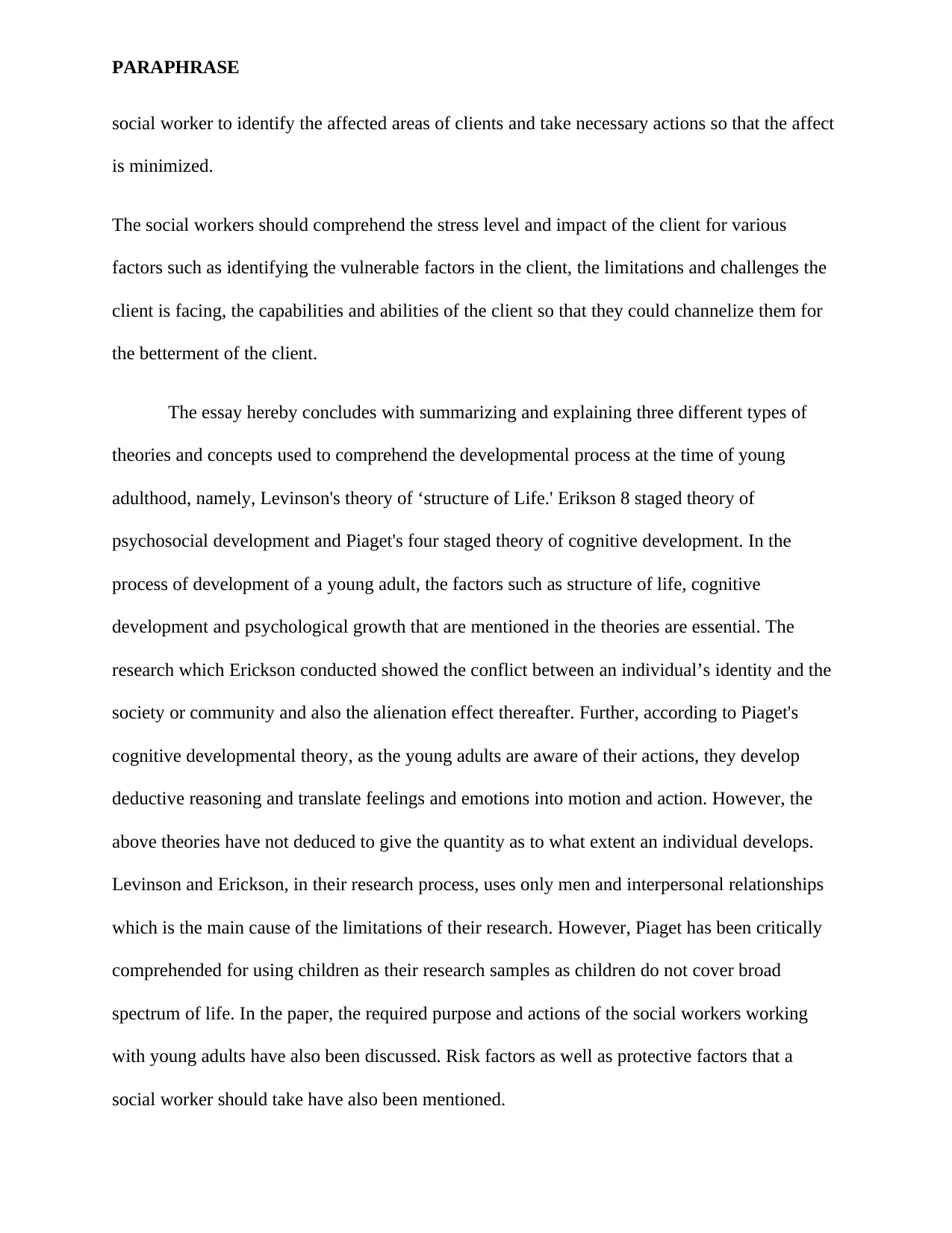
PARAPHRASE
social worker to identify the affected areas of clients and take necessary actions so that the affect
is minimized.
The social workers should comprehend the stress level and impact of the client for various
factors such as identifying the vulnerable factors in the client, the limitations and challenges the
client is facing, the capabilities and abilities of the client so that they could channelize them for
the betterment of the client.
The essay hereby concludes with summarizing and explaining three different types of
theories and concepts used to comprehend the developmental process at the time of young
adulthood, namely, Levinson's theory of ‘structure of Life.' Erikson 8 staged theory of
psychosocial development and Piaget's four staged theory of cognitive development. In the
process of development of a young adult, the factors such as structure of life, cognitive
development and psychological growth that are mentioned in the theories are essential. The
research which Erickson conducted showed the conflict between an individual’s identity and the
society or community and also the alienation effect thereafter. Further, according to Piaget's
cognitive developmental theory, as the young adults are aware of their actions, they develop
deductive reasoning and translate feelings and emotions into motion and action. However, the
above theories have not deduced to give the quantity as to what extent an individual develops.
Levinson and Erickson, in their research process, uses only men and interpersonal relationships
which is the main cause of the limitations of their research. However, Piaget has been critically
comprehended for using children as their research samples as children do not cover broad
spectrum of life. In the paper, the required purpose and actions of the social workers working
with young adults have also been discussed. Risk factors as well as protective factors that a
social worker should take have also been mentioned.
social worker to identify the affected areas of clients and take necessary actions so that the affect
is minimized.
The social workers should comprehend the stress level and impact of the client for various
factors such as identifying the vulnerable factors in the client, the limitations and challenges the
client is facing, the capabilities and abilities of the client so that they could channelize them for
the betterment of the client.
The essay hereby concludes with summarizing and explaining three different types of
theories and concepts used to comprehend the developmental process at the time of young
adulthood, namely, Levinson's theory of ‘structure of Life.' Erikson 8 staged theory of
psychosocial development and Piaget's four staged theory of cognitive development. In the
process of development of a young adult, the factors such as structure of life, cognitive
development and psychological growth that are mentioned in the theories are essential. The
research which Erickson conducted showed the conflict between an individual’s identity and the
society or community and also the alienation effect thereafter. Further, according to Piaget's
cognitive developmental theory, as the young adults are aware of their actions, they develop
deductive reasoning and translate feelings and emotions into motion and action. However, the
above theories have not deduced to give the quantity as to what extent an individual develops.
Levinson and Erickson, in their research process, uses only men and interpersonal relationships
which is the main cause of the limitations of their research. However, Piaget has been critically
comprehended for using children as their research samples as children do not cover broad
spectrum of life. In the paper, the required purpose and actions of the social workers working
with young adults have also been discussed. Risk factors as well as protective factors that a
social worker should take have also been mentioned.

Reference
Apt, Michael (1964) 7 UP Documentary Series. Granada Television for ITV
Durkin, K. (1995) Developmental Social Psychology
From Infancy to Old Age. . Blackwell Publisher Ltd. UK
Green, L. (2010) Understanding the Life Course
Sociological and Psychological Perspectives. Polity Press Cambridge UK
Matto, H. (2008) Young Adulthood in Dimensions of Human Behaviour.
The Changing Life Course. Hutchison, E.D (ed) (2008. 3edn)
Sage Publication Inc. UK
Sudbery, J. (2010) Human Growth and Development. An Introduction for Social Worker
Routledge. New York
Apt, Michael (1964) 7 UP Documentary Series. Granada Television for ITV
Durkin, K. (1995) Developmental Social Psychology
From Infancy to Old Age. . Blackwell Publisher Ltd. UK
Green, L. (2010) Understanding the Life Course
Sociological and Psychological Perspectives. Polity Press Cambridge UK
Matto, H. (2008) Young Adulthood in Dimensions of Human Behaviour.
The Changing Life Course. Hutchison, E.D (ed) (2008. 3edn)
Sage Publication Inc. UK
Sudbery, J. (2010) Human Growth and Development. An Introduction for Social Worker
Routledge. New York
⊘ This is a preview!⊘
Do you want full access?
Subscribe today to unlock all pages.

Trusted by 1+ million students worldwide
1 out of 9
Related Documents
Your All-in-One AI-Powered Toolkit for Academic Success.
+13062052269
info@desklib.com
Available 24*7 on WhatsApp / Email
![[object Object]](/_next/static/media/star-bottom.7253800d.svg)
Unlock your academic potential
Copyright © 2020–2025 A2Z Services. All Rights Reserved. Developed and managed by ZUCOL.





